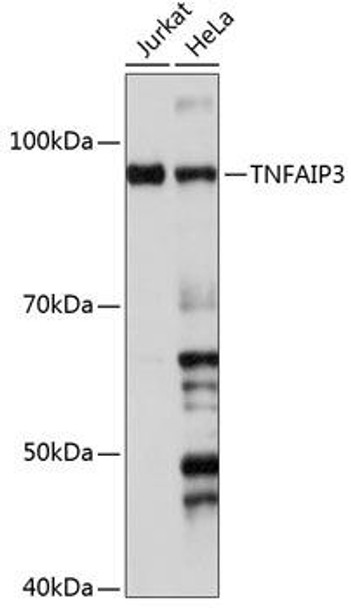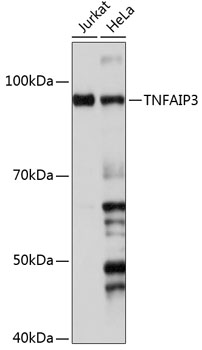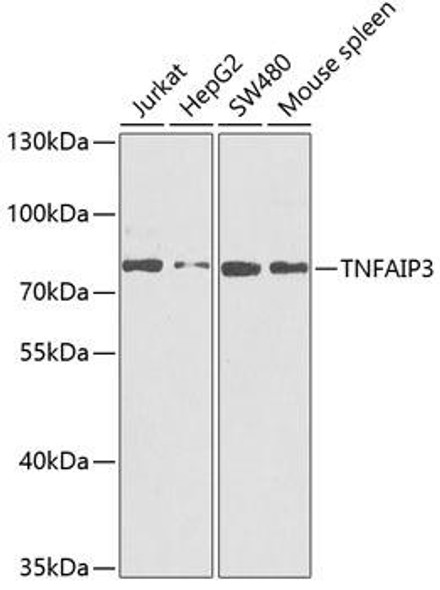Anti-TNFAIP3 Antibody (CAB19128)
- SKU:
- CAB19128
- Product type:
- Antibody
- Reactivity:
- Human
- Host Species:
- Rabbit
- Isotype:
- IgG
- Research Area:
- Cell Death
Description
| Antibody Name: | Anti-TNFAIP3 Antibody |
| Antibody SKU: | CAB19128 |
| Antibody Size: | 20uL, 50uL, 100uL |
| Application: | WB IHC |
| Reactivity: | Human |
| Host Species: | Rabbit |
| Immunogen: | A synthesized peptide derived from human TNFAIP3 |
| Application: | WB IHC |
| Recommended Dilution: | WB 1:500 - 1:2000 IHC 1:50 - 1:200 |
| Reactivity: | Human |
| Positive Samples: | Jurkat, HeLa |
| Immunogen: | A synthesized peptide derived from human TNFAIP3 |
| Purification Method: | Affinity purification |
| Storage Buffer: | Store at -20°C. Avoid freeze / thaw cycles. Buffer: PBS with 0.02% sodium azide, 0.05% BSA, 50% glycerol, pH7.3. |
| Isotype: | IgG |
| Sequence: | Email for sequence |
| Gene ID: | 7128 |
| Uniprot: | P21580 |
| Cellular Location: | |
| Calculated MW: | 82kDa |
| Observed MW: | 82kDa |
| Synonyms: | A20, AISBL, OTUD7C, TNFA1P2, TNFAIP3 |
| Background: | This gene was identified as a gene whose expression is rapidly induced by the tumor necrosis factor (TNF). The protein encoded by this gene is a zinc finger protein and ubiqitin-editing enzyme, and has been shown to inhibit NF-kappa B activation as well as TNF-mediated apoptosis. The encoded protein, which has both ubiquitin ligase and deubiquitinase activities, is involved in the cytokine-mediated immune and inflammatory responses. Several transcript variants encoding the same protein have been found for this gene. [provided by RefSeq, Jul 2012] |
| UniProt Protein Function: | TNFAIP3: Ubiquitin-editing enzyme that contains both ubiquitin ligase and deubiquitinase activities. Involved in immune and inflammatory responses signaled by cytokines, such as TNF-alpha and IL-1 beta, or pathogens via Toll-like receptors (TLRs) through terminating NF-kappa-B activity. Essential component of a ubiquitin-editing protein complex, comprising also RNF11, ITCH and TAX1BP1, that ensures the transient nature of inflammatory signaling pathways. In cooperation with TAX1BP1 promotes disassembly of E2-E3 ubiquitin protein ligase complexes in IL-1R and TNFR-1 pathways; affected are at least E3 ligases TRAF6, TRAF2 and BIRC2, and E2 ubiquitin-conjugating enzymes UBE2N and UBE2D3. In cooperation with TAX1BP1 promotes ubiquitination of UBE2N and proteasomal degradation of UBE2N and UBE2D3. Upon TNF stimulation, deubiquitinates 'Lys-63'-polyubiquitin chains on RIPK1 and catalyzes the formation of 'Lys-48'-polyubiquitin chains. This leads to RIPK1 proteasomal degradation and consequently termination of the TNF- or LPS-mediated activation of NF-kappa-B. Deubiquinates TRAF6 probably acting on 'Lys-63'-linked polyubiquitin. Upon T-cell receptor (TCR)-mediated T-cell activation, deubiquitinates 'Lys-63'-polyubiquitin chains on MALT1 thereby mediating disassociation of the CBM (CARD11:BCL10:MALT1) and IKK complexes and preventing sustained IKK activation. Deubiquinates NEMO/IKBKG; the function is facilitated by TNIP1 and leads to inhibition of NF-kappa-B activation. Upon stimulation by bacterial peptidoglycans, probably deubiquitinates RIPK2. Can also inhibit I-kappa-B-kinase (IKK) through a non-catalytic mechanism which involves polyubiquitin; polyubiquitin promotes association with IKBKG and prevents IKK MAP3K7-mediated phosphorylation. Targets TRAF2 for lysosomal degradation. In vitro able to deubiquitinate both 'Lys-48'- and 'Lys-63' polyubiquitin chains. Inhibitor of programmed cell death. Has a role in the function of the lymphoid system. Homodimer. Interacts with TNIP1, TAX1BP1 and TRAF2. Interacts with RNF11, ITCH and TAX1BP1 only after TNF stimulation; these interaction are transient and they are lost after 1 hour of stimulation with TNF. Interacts with YWHAZ and YWHAH. Interacts with IKBKG; the interaction is induced by TNF stimulation and by polyubiquitin. Interacts with RIPK1. Interacts with UBE2N; the interaction requires TAX1BP1. Interacts with TRAF6; the interaction is inhibited by HTLV-1 protein Tax. By TNF. Belongs to the peptidase C64 family. |
| UniProt Protein Details: | Protein type:EC 3.4.19.12; Ubiquitin conjugating system; Apoptosis; Protease Chromosomal Location of Human Ortholog: 6q23 Cellular Component: centrosome; lysosome; cytoplasm; nucleus; cytosol Molecular Function:protein binding; ubiquitin binding; DNA binding; protease binding; protein self-association; zinc ion binding; ubiquitin-specific protease activity; ubiquitin-protein ligase activity; kinase binding; ligase activity Biological Process: negative regulation of toll-like receptor 5 signaling pathway; negative regulation of smooth muscle cell proliferation; apoptosis; proteolysis; negative regulation of toll-like receptor 3 signaling pathway; negative regulation of interleukin-2 production; negative regulation of innate immune response; response to molecule of bacterial origin; negative regulation of interleukin-6 production; negative regulation of bone resorption; inflammatory response; negative regulation of chronic inflammatory response; protein deubiquitination; negative regulation of toll-like receptor 2 signaling pathway; B-1 B cell homeostasis; negative regulation of cyclin-dependent protein kinase activity; negative regulation of B cell activation; negative regulation of I-kappaB kinase/NF-kappaB cascade; negative regulation of tumor necrosis factor production; negative regulation of interleukin-1 beta production; protein oligomerization; regulation of germinal center formation; response to muramyl dipeptide; inhibition of NF-kappaB transcription factor; negative regulation of inflammatory response; negative regulation of toll-like receptor 4 signaling pathway; positive regulation of protein catabolic process; innate immune response; negative regulation of protein ubiquitination; regulation of defense response to virus by host; negative regulation of interferon type I production |
| NCBI Summary: | This gene was identified as a gene whose expression is rapidly induced by the tumor necrosis factor (TNF). The protein encoded by this gene is a zinc finger protein and ubiqitin-editing enzyme, and has been shown to inhibit NF-kappa B activation as well as TNF-mediated apoptosis. The encoded protein, which has both ubiquitin ligase and deubiquitinase activities, is involved in the cytokine-mediated immune and inflammatory responses. Several transcript variants encoding the same protein have been found for this gene. [provided by RefSeq, Jul 2012] |
| UniProt Code: | P21580 |
| NCBI GenInfo Identifier: | 112894 |
| NCBI Gene ID: | 7128 |
| NCBI Accession: | P21580.1 |
| UniProt Secondary Accession: | P21580,Q2HIX9, Q5VXQ7, Q9NSR6, B2R767, E1P588, |
| UniProt Related Accession: | P21580 |
| Molecular Weight: | 790 |
| NCBI Full Name: | Tumor necrosis factor alpha-induced protein 3 |
| NCBI Synonym Full Names: | tumor necrosis factor, alpha-induced protein 3 |
| NCBI Official Symbol: | TNFAIP3 |
| NCBI Official Synonym Symbols: | A20; OTUD7C; TNFA1P2 |
| NCBI Protein Information: | tumor necrosis factor alpha-induced protein 3; zinc finger protein A20; TNF alpha-induced protein 3; OTU domain-containing protein 7C; putative DNA-binding protein A20; tumor necrosis factor inducible protein A20 |
| UniProt Protein Name: | Tumor necrosis factor alpha-induced protein 3 |
| UniProt Synonym Protein Names: | OTU domain-containing protein 7C; Putative DNA-binding protein A20; Zinc finger protein A20Cleaved into the following 2 chains:A20p50; A20p37 |
| Protein Family: | TNFAIP3-interacting protein |
| UniProt Gene Name: | TNFAIP3 |
| UniProt Entry Name: | TNAP3_HUMAN |







